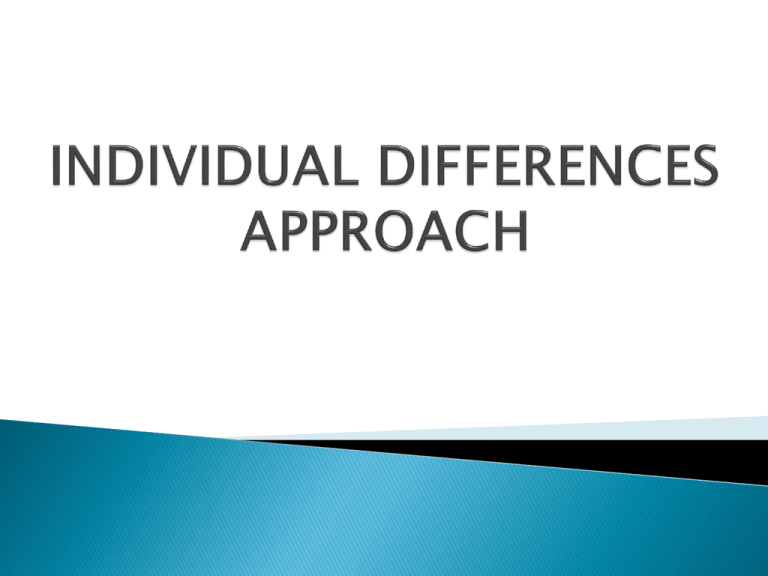
Lots of research looks at
the “typical” or “average”
person
But what about unusual
people?
Psychologists of
individual differences
study what makes people
DIFFERENT
PERSONAL QUALITIES
Personality
Intelligence
Moral values
Mental health
GROUP IDENTITIES
Race
Culture
Gender
In the Middle Ages, people were
grouped by their “humours”
(mentioned in Shakespeare)
Humours = magical fluids that run
through the body
Sanguine personalities had too
much blood: they were OUTGOING
& EXCITABLE
In the 20th century, WILLIAM
SHELDON proposed idea of
“somatotypes”
Somatotypes = body shapes
ENDOMORPHS sociable
ECTOMORPHS solitary
MESOMORPHS risk-taking,
dominant
5
Modern psychology is more interested in
personality TRAITS
Traits = DISPOSITIONS we all share, but to varying
degrees
The BIG FIVE
1. Extraversion (outgoing)
2. Neuroticism (moody)
3. Agreeableness (nice)
4. Conscientiousness (dependable)
5. Openness to experience (flexible/imaginative)
Self-reports
PSYCHOMETRIC TESTS
Questionnaires that give a SCORE to your
mental characteristics
Eg personality quiz
Most famous is the EYSENCK PERSONALITY
QUESTIONNAIRE (1975)
Measures Extraversion & Neuroticism
PROJECTIVE TESTS
Activity which asks the
respondent to be creative
Interprets hidden meaning in
their response
Herman Rorschach created
inkblot test
What can you see in the blot?
Social psychologists say SITUATIONS are
more important than dispositions
Behaviourists say personality is just a set of
BEHAVIOURS we have learned
Is there a PERSONALITY that stays the same in
all situations?
Can we have MULTIPLE PERSONALITIES?
EXPLANATIONS OF BEHAVIOUR
MULTIPLE
PERSONALITY
DISORDER
“Eve White”, American housewife (25)
treated for amnesia/depression using
hypnosis
New personality appears! “Hello doc!”
Eve Black is EW’s opposite: fun-loving,
sexy, destructive, amoral
Scores differently on psychometric &
projective tests… different
handwriting!
Later, 3rd personality (Jane) emerges
Doctors try to persuade EW & EB to
“merge” with healthier Jane
Joanne Woodward
got an Oscar for the
film of the case
study – The Three
Faces of Eve (1957)
What is “madness”?
Before we can cure it, can we
even define it?
In the UK, 1 in 6 adults is
affected by mental distress at
any one time
Anxiety & depression affect
9% of adults each year
Diagnoses are set out in
DSM-IV (in USA) or ICD (in UK
and elsewhere)
EXPLANATIONS OF BEHAVIOUR
PSYCHIATRIC
DIAGNOSIS OF
INSANITY
NOT the same as multiple
personality disorder
Means “shattered mind”
Many different symptoms, not
all sufferers have them all:
Delusions
Hallucinations/hearing voices
Inappropriate emotions
Involuntary movements
No biological test for
schizophrenia – only selfreports
Around 1% of population will
suffer from schizophrenia
Between 2-4 in 1000 in any
year
Similar for men/women –
shows in late teens for men,
but mid-thirties for women
Treated with anti-psychotic
drugs…
… but they have side-effects
(tremors, facial tics, etc)
Thomas Szasz (1960) wrote about
the “myth of mental illness”
No such thing as “mental illness”
Illnesses have a biological defect
and produce physical symptoms
Madness is unacceptable beliefs
or problems in living!
Argues blaming it on “illness” like
blaming on witches in 17th
century
Side effect of certain drugs (LSD,
mescaline)
Commonly reported by bereaved
people
Joan of Arc heard voices from age
12 – told her to wage war on the
English!
English decided not God but the
Devil – they burnt her
Voices often disturbing, but can
be comforting or inspirational
David Rosenhan wanted to
investigate if experts can diagnose
mental illness
Sent 8 “pseudopatients” into mental
hospitals saying they heard voices
All admitted with schizophrenia
How long would it take to get out?
Average 19 days
Staff interpreted ordinary behaviour
as evidence of madness
STICKY LABELING
Is there an “addictive personality”?
How do addicts differ from normal
(non-addicted) people?
BIOLOGICAL EXPLANATION
“Pleasure centres” in the brain
Genetic component?
Gene DRD2 appears in 42% of people
with alcoholism
Also found in 25% of general
population
May be a genetic link – but needs
more explanation than this
BEHAVIOURAL EXPLANATION
We become addicted to
behaviours, not just to
substances
EG shopping, gambling, sex,
work, fitness, World of
Warcraft
SALIENCE – how important it
is
EUPHORIA – pleasurable
TOLERANCE & WITHDRAWAL
CONFLICT & RELAPSE
Heuristics are “rules of thumb” that help us in our
thinking
Cognitive strategies for solving problems
Willem Wagenaar proposed 16 heuristics,
including:
ILLUSION OF CONTROL
Having “lucky numbers”, a “favourite” slot
machine
FLEXIBLE ATTRIBUTIONS
Losses are “near misses”, successes due to own
skill – good for self-esteem
FIX ON ABSOLUTE FREQUENCY
Count total winnings, not proportion of money
spent
Explore thought processes of gamblers
30 regular gamblers (RGs), 30 NRGs,
recruited through adverts or personal
contact
Given £3 stake on a fruit machine
Half asked to verbalise their thoughts
RGs played more games, lost more when
they verbalised and made more
irrational verbalisations
RGs believed own skill was factor in
winning
Suggests cognitive therapy for gambling
addicts
EXPLANATIONS OF BEHAVIOUR
ADDICTIVE
BEHAVIOUR
Focuses on the differences between people (rather than things we might have
in common).
There are differences between the people of any group, in terms of their
personal qualities, the ways in which they respond to situations, their
behaviour and so on. Examining these differences is what is most revealing.
Assumes what makes us individual makes us behave as individuals e.g.
intelligence and personality, but could also be through abnormality (such as
mental disorders), gender and race.
Other research has tried to categorise & identify different types of
abnormality.
Individual differences are measured using psychometric tests e.g.
IQ/personality tests.
25
Provides useful explanations for human
behaviour by investigating individual cases.
Some of the explanations provided can be
considered as useful in improving the
experiences of people with mental health
problems
Important individual differences tends to be over
looked by other approaches.
The easy analysis of the quantitative data
psychometric tests produce lead to the
identification of the differences between people.
It is difficult to make generalisations from
research focusing on an individual (case
study).
There is a danger of labelling people &
perhaps encouraging discrimination.
Research often carried out on limited samples
from one culture.
If you study unusual or extraordinary people, can
you GENERALISE the results to others?
Is Eve White/Black typical of MPD (multiple
personality disorder) sufferers?
Can you generalise from research on
schizophrenia to ALL mental illness?
What do fruit machine addicts tell you about
other sorts of gamblers? Or other sorts of
addicts?
WHAT ABOUT ETHNOCENTRISM?
Talking to the dead is a coping strategy among
West Indians – often misdiagnosed as
schizophrenia by white doctors
Black people are 5% of UK population, but 25% of
psychiatric patients are black…












